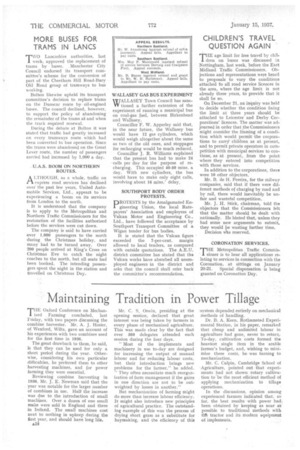Maintaining Tradition in Power Tillage
Page 52

If you've noticed an error in this article please click here to report it so we can fix it.
T'EOxford Conference on Mechanized Farming concluded, last Friday, with two papers discussing the combine harvester. Mr. A. J. Hosier, of Wexford, Wilts, gave an account of his experiences with two combines used for the first time in 1936.
The great drawback to them, he said, is that they can be used for only a short period during the year. Otherwise, considering his own particular difficulties, he preferred them to other harvesting machines, and for power farming they were essential.
Reviewing combine harvesting in 1936, Mr. J. E. Newman said that the year was notable for the larger number of combines in use. Half the increase was due to the introduction of small machines. Over a dozen of one small make. were sold in England and three in Ireland. The small machines cost next to nothing in upkeep during the first year, and should have long life. A:34 Mr. C. S. Oswin, presiding at the opening session, declared that great interest was being taken by farmers in every phase of mechanized agriculture. This was made clear by the tact that over 350 delegates attended each session during the four days.
" Most of the implements and machinery in use to-day are designed for increasing the output of manual labour and for reducing labour costs, but their introduction brings new problems for the farmer," he added. " They often necessitate much reorganization of farm management if the gains in one direction are not to be outweighted by losses in another."
But mechanization of farming might do more than increase labour efficiency. It might also introduce new principles of agricultural practice. The outstanding example of this was the process of drying short grass as a substitute for haymaking, and the efficiency of this system depended entirely on mechanical methods of handling.
Dr. B. A. Keen, Rothamsted Experimental Station, in his paper, remarked that cheap and unlimited labour in agriculture had gone, never to return.
To-day, cultivation costs formed the heaviest single item in the arable farmer's budget, and, wishing to minimize these costs, he was turning to mechanization, • Mr. C. Culpin, Cambridge School of Agriculture, pointed out that experi ments had not shown rotary cultivation to be the most efficient method of applying mechanization to tillage operations.
In the discussions, opinion among experienced farmers indicated that, so far, the best results with power had been obtained by keeping as near as possible to traditional methods with tht tractor arid its modern equipment of implements.




















































































